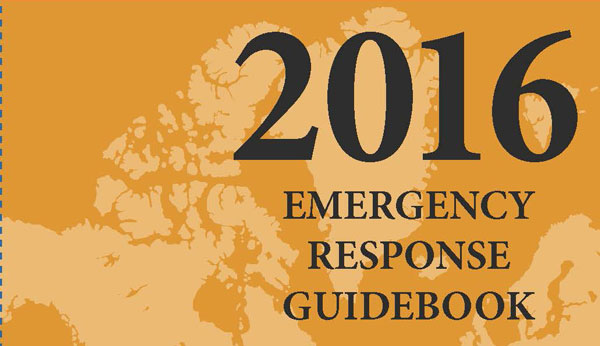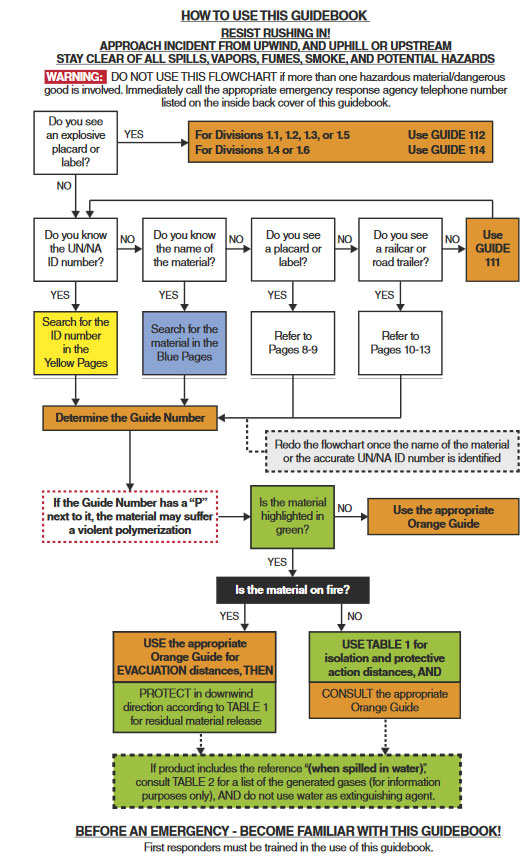
By Stephen L. Hermann
The release of the newly revised 2016 Emergency Response Guidebook (ERG), the country’s most widely used hazardous materials reference, has been anticipated for months by thousands of fire departments across the U.S. and Canada. As noted in a bold black box on the revised front and back covers, the ERG is a guidebook intended for use by first responders during the initial phase of a transportation incident involving dangerous goods/hazardous materials. The new ERG2016 is posted online at: http://phmsa.dot.gov/hazmat/outreach-training/erg.
Updated every four years as a collaborative effort of the U.S. Department of Transportation (USDOT), Transport Canada, and Mexico’s Secretariat of Transport and Communications, about 14.5 million copies of previous ERGs have been distributed. This year, more than 1.5 million free copies of the guidebook will be distributed to firefighters, emergency medical technicians, and law enforcement officers across the nation by designated state emergency management coordinators’ offices.
The revised ERG2016 includes general updates to the ERG2012, expanded sections and hundreds of technical changes, but no major revisions. The guidebook retains its strongest asset–the use of vital, nontechnical, easy-to-follow information in a brief, practical form.
The ERG2016 contains features introduced in previous ERGs, such as:
- Recommended distances are in metric and English units.
- The term “dangerous goods” is synonymous with “hazardous materials.”
- The term “toxic” is synonymous with “poison” and “poisonous.”
- Two-page orange-border guide on what to do.
- The suffix “P” is added to guide numbers to indicate a polymerization hazard.
- Each guide shows the broad types of materials covered.
- The term “protective action distance,” along with an explanation of “shelter in place” replaces “evacuation distance.”
- “Table 1 – Initial Isolation and Protective Action Distances” pages are bordered in green for quick access.
- Simple, easy-to-understand advice.
In the new ERG2016 revision, the following items have been expanded and/or revised from the ERG2012:
“How to use this Guidebook” instructions on Page 1 are now in a flowchart (“decision tree” or “decision/logic chart”) replacing the ERG2012 “Step 1, Step 2, Step 3″ method.

To breakdown the changes from the previous version, it may be easiest to illustrate by comparing the color-coded pages.
The WHITE General Information pages show:
- Shipping documents (Papers)
- Table of markings, labels, and placards and initial response guide to use on-scene
- Rail Car and Road Trailer Identification Charts (with more detailed information on each)
- Pipeline transportation
- Improvised Explosive Device (IED) safe stand off distance chart
- Glossary
- Emergency Response Telephone Numbers
New sections have been added to the WHITE General Information pages as follows:
- Local emergency response numbers (blank, to be filled in by user)
- Table of Contents
- Globally harmonized systems (GHS) of classification and labeling of chemicals
- Information about emergency response assistance plans (ERAP) for Canadian users
The YELLOW-bordered Index List of Dangerous Goods in Order of ID Number pages and BLUE-bordered Index List of Dangerous Goods in Alphabetical Order pages include:
- Addition of all new dangerous goods listed in the UN Recommendations on the Transport of Dangerous Goods, up to the 19th Revised Edition
The ORANGE-bordered Emergency Response Guides (“Guides”) pages reflect:
- Minor revisions of some guides
- Two guides have been added (# 173 and # 174) for adsorbed gases
- Identification of potential emergency response assistance plan (ERAP) products for Canadian users
The GREEN-bordered Table of Initial Isolation and Protective Action Distances pages identify:
- Hundreds of updated initial isolation and protective action distances (Tables 1 and 3) based on new toxicity data and reactivity research
- Added “Estimating wind speed from environmental clues” for Table 3
The guidebook’s initial white pages contain reference and usage information, definitions, and general guidance, including examples of shipping papers, markings, and placards. Information on explosives directs users to Guide 112 (orange-bordered pages) for all explosives except for explosives 1.4 (explosives C) and explosives 1.6 (extremely insensitive articles), for which they are directed to Guide 114. If no specific chemical information is available, turn to Guide 111 and use it until additional information is available.
Page 4 offers the following “Safety Precautions,” which are explained in detail:
RESIST RUSHING IN
1. Approach cautiously from upwind, uphill or upstream.
2. Secure the scene.
3. Identify the hazards using any of the following:
4. Assess the situation.
5. Obtain help.
6. Respond.
7. Above all (i.e., cautions).
On page 6, the DOT hazard class and division numbers are shown with corresponding hazard class names: e.g., “Class 2 – Gases,” “Division 2.1 – Flammable Gases.” Many trucking companies use the international hazardous materials placards that do not utilize the hazard class names, but use numbers instead.
One of the most valuable features of ERG2016 remains the “Table 1 – Initial Isolation and Protective “Action Distances,” starting on page 294. The preceding “Introduction” starts on page 289 and covers protective action decision factors, protective actions, background on the table, and how to use it. Table 1 covers those chemicals that are toxic or poisonous by inhalation, and gives suggested initial isolation distances at the scene. It then recommends “Protective Action Distances,” which could involve either evacuation or “shelter in place.” This recognizes that most business buildings or homes can provide air that is cleaner than that which evacuees might encounter in trying to leave an area of a toxic chemical cloud.
Substances are indexed in the yellow- and blue-bordered pages. Both indexes direct you to the appropriate orange-bordered Guide page, which gives the recommended do’s and dont’s. In the yellow-bordered pages, substances are listed in numerical order, according to the four-digit identification number assigned by either the United Nations, or a North American committee (UN or NA prefix.) The blue-bordered pages alphabetically list chemicals, and again refer you to the proper orange-bordered page Guide for emergency response information. Entries highlighted in green in the yellow or blue indexes indicate the chemicals that are poisonous when inhaled, and require users to see the green-bordered pages, which includes “Table 1- Initial Isolation and Protective Action Distances.”
The orange-bordered page Guides are divided into “Potential Hazards,” “Public Safety,” and “Emergency Response” sections:
- Potential Hazards” explains the possible hazards involved with the material and covers “Fire or Explosion” risk and “Health,” which lists the substance’s physical and toxicological hazards. The highest potential is listed first.
- “Public Safety” gives guidance on general and evacuation information, and immediate isolation of the incident site for public protection, and protective clothing advice.
- “Emergency Response” is divided into three sections dealing with action planning data. “Fire” indicates recommended fire suppression and control actions, “Spill or Leak” addresses recommended actions for actual spills, and “First Aid” offers health action advice prior to seeking medical care.
The green-bordered “Table 1- Initial Isolation and Protective Action Distances” pages provide the recommended minimum distances at which to keep people away from spills of hazardous materials that produce poisonous effects when inhaled.
The two areas of concern are the Initial Isolation Zone and the Protective Action Zone. The Initial Isolation Zone is the area where persons may be exposed to dangerous and life-threatening concentrations of materials. This is in all directions from the spill center. The Protective Action Zone is where downwind persons may become incapacitated and unable to take protective action or suffer serious or irreversible health effects. The public may be endangered for downwind distances of up to 11+ km (7+ miles). The Protective Action Zone is a square where the downwind width is the same as its length.
Hundreds of these distances have been revised from ERG2012. For example, on the first of 51 green-bordered pages, it lists 12 chemicals with 11 changes to recommended distances; two have been increased and nine have been decreased. In some cases, distances have been cut in half or more, as in methyl bromide where the day protective action distance for a small spill has decreased from 0.6 to 0.3 km, and for a night large spill from 1.9 km to 0.7 km.
Chemical warfare agents are listed alphabetically in the blue-bordered pages using their common names, e.g., tabun, sarin, and soman, and their common abbreviations, GA, GB, and GD. The four pages on chemical, biological, and radiological agents were developed by the Department of National Defence (Canada), the U.S. Department of the Army Aberdeen Proving Ground, and the Federal Bureau of Investigation. They discuss
- differences between chemical, biological and radiological agents,
- indicators of a possible chemical incident,
- indicators of a possible biological incident,
- indicators of a possible radiological incident, and
- personal safety considerations.
In the United States, according to the requirements of the U.S. Department of Labor’s Occupational Safety & Health Administration (OSHA, 29 CFR 1910.120) and regulations issued by the U.S. Environmental Protection Agency (EP”, 40 CFR Part 311), first responders must be trained regarding the use of this guidebook. USDOT’s primary objective is to place one copy of the ERG2016 in each publicly owned emergency service vehicle.
Emergency service organizations that have not yet received copies of ERG2016 should contact the respective distribution center in their country, state, or province. In the U.S., information about the distribution center for your location may be obtained from Office of Hazardous Materials Safety Web site at http://phmsa.dot.gov/hazmat/outreach-training/erg or call 202-366-4900. The Web site also offers a free, full PDF file copy of ERG2016, and links to English, Spanish, and French interactive versions.
Your emergency service vehicle should always contain a copy of this book, which has become one of the most popular publications ever printed by the U.S. Government.
STEPHEN L. HERMANN CEM retired as the hazardous materials coordinator for the Arizona Department of Public Safety and as Arizona’s senior state on-scene coordinator for hazardous materials emergency response. He is also a retired U.S. Army Reserve Chemical Corps colonel. He has supervised more than 200 serious hazardous materials highway and rail incidents over the past 25 years. Hermann has a bachelor of science degree in explosives technology from the University of Minnesota and is a graduate of the U.S. Naval School Explosive Ordnance Disposal, United States Army Command and General Staff College, and the U.S. Army War College. He is a Senior Executive Fellow, John F. Kennedy School of Government, Harvard University. He teaches hazardous materials courses around the U.S. and Canada.


